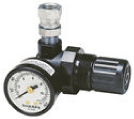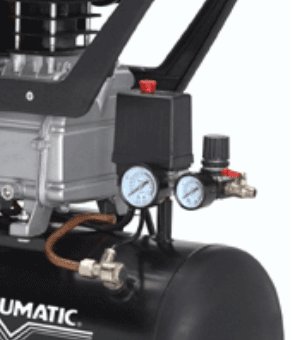When operating an air compressor, for successful operations and projects, the pressure of the air itself is likely to be the most important factor. You need to make sure that the settings are correct for each application to get the right amount of pressure for a successful operation.
To have the right settings, you may need to make adjustments, using the feature known as the air compressor pressure regulator. This article will provide you with all the relevant information on how to adjust an air compressor pressure regulator.
Table of Contents
- Why Regulate Your Air Compressor?
- How to Adjust Air Compressor Pressure Regulator Guide
- Pressure Regulator Maintenance
- FAQs (Frequently Asked Questions)
Why Regulate Your Air Compressor?
Regulating air compressors allows you to control the flow of air passing through the entire system, which is possible on of the most important components of an air compressor. Without a compressor pressure regulator there would be no way to regulate and control the pressure and intensity of the air flowing from the air compressors tank into your pneumatic tools.
Having a regulator in place will enable you to protect each tool from either being over powered or under powered, and in doing so, also protects the quality of your pneumatic applications.

Air pressure regulators are therefore extremely valuable because different types of pneumatic tools require different levels of pressure. If you were the power a fast-moving operation with the same amount of pressure needed for a slow-moving tool then the operation would likely yield very poor results. If you did the opposite, you would be overpowering your tool.
Regulating an air compressor will help reduce the amount of energy required to run your air-powered operations. If you did not have the functions of a pressure regulator, you may end up consuming high volumes of energy throughout each day of use just to meet peak demands, even if only a fraction of your applications require this much energy.
So, the main reasons to regulate your air compressor are:
- Properly serve your air tools
- Streamline applications
- Save energy
How to Adjust Air Compressor Pressure Regulator Guide
Every time you attach a different pneumatic tool to your air compressor, it may be necessary to adjust the pressure to meet the PSI requirements of each varying tool. Therefore, I will provide to you a step-by-step guide on how to adjust an air compressor pressure regulator before you swap the tools about.

Turn Air Compressor On
First of all, you will need to power on the air compressor and get it warmed up for a normal operating cycle so that you’re able to make an accurate pressure gauge adjustment. You should give the tank enough time (several minutes or so) to fill up with its newly pressurized air.
You can easily ascertain whether the air is filling up from the noise your air compressor makes when you turn it on.
Note: It is very important to have a full tank of air for this adjustment process.
Check PSI Compatibility of the Tool
Once the compressor has be powered on and the tank is sufficiently full of air, you should check the PSI rating on the pneumatic tool that you’ve set aside to be used next. If the PSI of the tool exceeds the capacity of the air compressor, you will need to reserve that tool for a different compressor that has a higher capacity.
If the air compressor pressure exceeds the requirements of the tool at hand, then you can certainly carry on with this adjustment routine.
Connect the Tool and Air Hose
Now you may attach the pneumatic tool to the air hose and then attach the hose to the air compressor (if it’s not attached already). I’m presuming you’re knowledgeable on how to attach a tool, but if you’re not and maybe you’re connecting this tool for the first time, look for the port on the instrument. If you are unable to pinpoint this feature, then consult the user’s manual to find the port.
Adjust the Pressure Regulator
With the tool and hose connections secured, you can begin to adjust the settings on the pressure regulator to match the PSI requirements of the tool attached. In most cases, there will be a knob located on the right-hand side of the pressure regulator.
On some compressors, the knob might be located in a different position on the machine. If so, consult the user’s manual to pinpoint the knob of the air compressor pressure regulator.
Unlocking the Regulator Knob
On the majority of air compressor regulators, there tends to be a locking feature that must be released to turn the knob. In most cases, the lock will be push-pull activated. To release the knob from its locked position so that you can adjust it, pull the knob outwards. To re-lock the knob, push it back inwards.
Of course this may vary depending on your compressor brand and model, so if this does not help you, please consult the user’s manual for information on the pressure regulator lock for your specific compressor.
Adjust the Pressure Up or Down
The increase and intensify the pressure inside the air tank of an air compressor, turn the regulator knob in a clockwise direction. The increase of pressure should be apparent immediately from the sound of the machine and the readings on the pressure gauge. Once you bring the regulator to its desired pressure, push the knob back in to lock that setting in place!
The same applies to decreasing the pressure, but instead, perform this in reverse. Turn the regulator knob counterclockwise until the pressure is lowered to the desired amount and then push the knob back into the locked position.
Sometimes, however, the air compressor may not build pressure as desired, visit our Why an Air Compressor Won’t Build Pressure & How to Fix a Compressor Not Building Pressure guide for help!
Pressure Regulator Maintenance
It is extremely important to do proper maintenance checks on your air compressor pressure regulator as it is to keep your air compressor in good condition. Pressure regulators tend to give rise to certain problems over the course of time due to a lack of maintenance.
One of the most common problems is cracks that become prevalent in the regulator. These cracks develop due to the continuous downstream movement of pressure through the regulator. Once the cracks have formed, they allow air to start leaking out of the air compressor system, thereby significantly reducing its capabilities. This also, in turn, affects the performance of the air tools and end applications.
If you do not use your air compressor that often, and instead maybe only use it occasionally, then you have a great chance of exposing the pressure regulator to risk of drying out. Thus, more occasional runtime should go a long way in prolonging the life of the pressure regulator.
If you do face pressure regulator issues, sleep well knowing that replacements in case of damage are inexpensive and readily available!
FAQs (Frequently Asked Questions)
To adjust your air pressure regulator, you must first unlock the adjustment knob by pulling the knob outwards (this may vary on different brands and models) and then turn the knob either clockwise for an increase in pressure, or anticlockwise for a decrease in pressure. Once you have adjusted the air pressure to your desired amount, push the button back in place and you’ve set your new pressure.
To increase the pressure on your air compressor, you must pull out the adjustment knob on your pressure regulator and turn it clockwise until to reach your desired pressure, then simply push the knob back in place to set the pressure.
Regulated pressure is pressure that has been either dialled down or up in an air compressor system via the use of a pressure regulator to control and set the amount of pressure flowing to your air tools. Regulated pressure enables you to provide each varying tool with it’s required pressure and avoid overpowering or underpowering the tool.
If you have any questions regarding how to adjust an air compressor regulator, please leave a comment below, with a photo if applicable, so that someone can help you!
